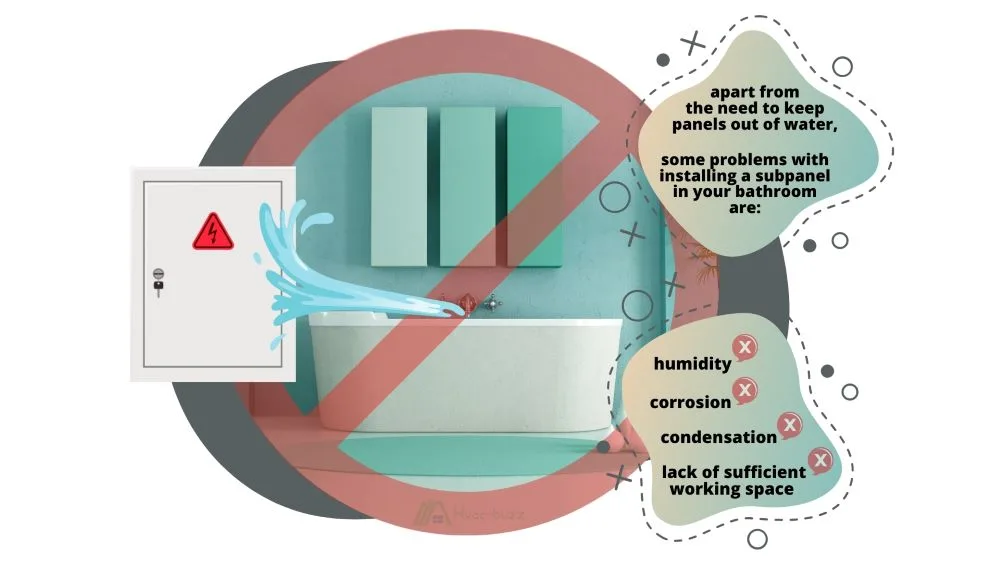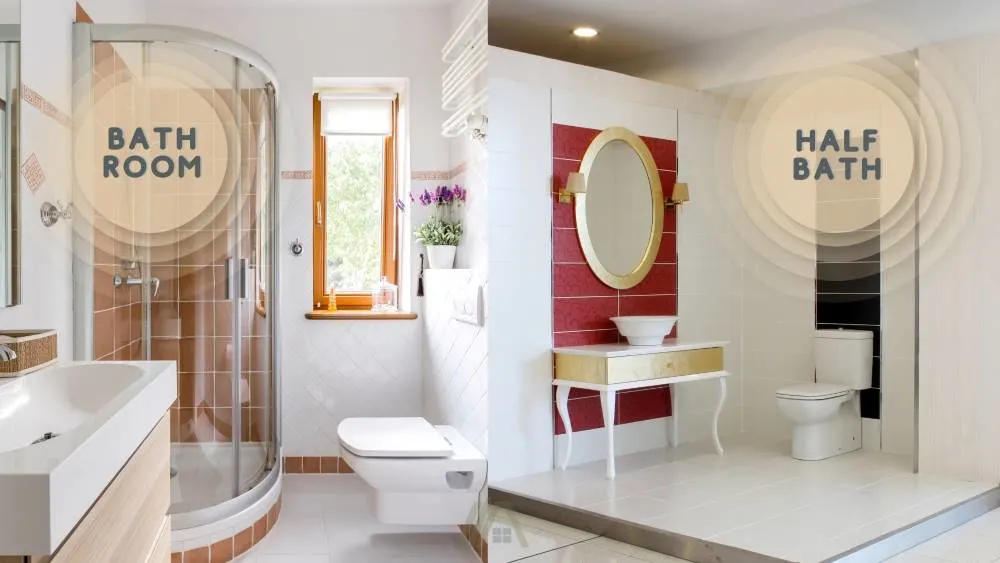Your bathroom can have a lot of electrical appliances, such as a water heater, spa tub, exhaust fan, and steam shower. It would be convenient to have a subpanel in the bathroom, which would mean that you could access the appliances and equipment along with their controls all in one place.
Unfortunately, the bathroom is a “no-go” according to coding regulations. What about old subpanels that are already in there or how about a half bath? But more importantly, let’s take a look at where else you can put your subpanel.

As per the IRC and NEC, a subpanel can not be installed in a bathroom or half bath. While subpanels can be protected against moisture, the prohibition likely exists because of evidence of foolish installation in places like showers. If the bathroom subpanel was installed before 1993, it can be grandfathered in.
Subpanels Cannot Be Installed in Bathrooms
Section E3405.1 (footnoted) of the International Residential Code (IRC) states the following:
“Panelboards, service equipment and similar enclosures shall not be located in bathrooms, toilet rooms, clothes closets or over the steps of a stairway.”
The National Electrical Code (NEC), which is the national standard in the US, has a similar statement in Chapter 2 Section 240.24(E):
“Not Located in Bathrooms. In dwelling units, dormitories, and guest rooms or guest suites, overcurrent devices, other than supplementary overcurrent protection, shall not be located in bathrooms.”
Supplementary overcurrent protection devices (OCPDs) are the specific protection for appliances and equipment and are generally internal to the appliance.
This means that you are prohibited by code to install a subpanel in a bathroom.
Another prohibited location for a subpanel is a clothes closet.
What Is the Reasoning Behind This Prohibition?
So, why can’t you install a subpanel in your bathroom?
Your initial thought, like mine, is probably because water and electricity are not a good combination. And you would be right in that respect; that’s just not the whole story.
I grew up with an outlet in my bathroom and thought it was so handy.
Unfortunately, it wasn’t exactly the safest idea when I look back. You should have seen the prongs of the hairdryer that got plugged in there! I saw it sparking once while the bathroom was humid and that was enough to convince me to never use the outlet again!
When my parents decided to spruce up the bathrooms in the house, the construction team informed us that outlets are not allowed in bathrooms anymore.
This makes a lot of sense to me now, so I can’t imagine that installing an entire subpanel is the best idea either, although subpanels are quite different to, and better protected against moisture than outlets.
However, there wasn’t always something wrong with having a subpanel in a bathroom. Older houses had them there. The reason that the IRC and NEC had to prohibit subpanels in bathrooms is that people trying to buy a new house found them in showers!
Perhaps if no one had installed electrics in their shower cubicle, you might not need to find a different location for your subpanel.
Apart from the need to keep panels out of water, there are some obvious issues with the bathroom as a location.
While not the official reason for the prohibition, these other problems with installing a subpanel in your bathroom are humidity, condensation, corrosion, and potentially a lack of sufficient working space.

Can Bathroom Subpanels Be Grandfathered In?
What do you do if you live in an old house that has a subpanel installed in the bathroom?
If the house is old and was built under a different version of the IRC and NEC that didn’t prohibit service subpanels in bathrooms, then you can probably get it grandfathered in.
This means getting a permit to have the subpanel there, provided the bathroom was built with the subpanel or the subpanel was installed before the coding changes. It might be helpful to call in a professional electrician or home inspector for more knowledgeable input.
Subpanels were permitted in bathrooms by the NEC until the 1993 edition, following which, that location became prohibited.
If the bathroom was built after 1993, then a panel in the bathroom is a violation of coding and will need to be removed.
If you are looking at buying a house with a panel in the bathroom, be sure to check with the sellers for the paperwork and think about getting an electrician in to inspect it.
If the papers show that the subpanel was installed after 1993, then the seller needs to get it up to code; it should not fall to the buyer’s expense.
What About a Half Bath?
A half bath consists of two main fixtures: a toilet, and a sink.
The IRC prohibits service panels and subpanels in toilet rooms. A toilet room is a different name for a half bath. This means that, while the bathroom group definition (IRC Section R202) doesn’t seem to include them, the actual code in Section E3405.1 prohibits half bath locations.
Chapter 1 of the NEC defines a bathroom as such:
“An area including a basin with one or more of the following: a toilet, a urinal, a tub, a shower, a bidet, or similar plumbing fixtures.”
You cannot install a subpanel in a half bath according to coding regulations.

Subpanel Alternative Locations
According to Section E3405.5 of the IRC, you cannot use the working space around the panelboards and OCPDs for storage, and they cannot be located in bathrooms, clothes closets, or over stairs.
The NEC Section 240.24, prohibits OCPDs from being located where they can sustain physical damage, near ignitable materials, bathrooms, and over stairs.
The IRC Section E3405.2 requires a workspace 36” deep and 30” wide in front of the subpanel and extending from the floor to a height of 6’5” (or the top of the equipment if it is taller). Lighting for the service panel is also required by Section E3405.7.
So, if not the bathroom, where can you install the subpanel while keeping it within easy access (in other words, not an outside shed or the like)?
Provided these areas don’t violate any regulations, according to the above requirements, here are some locations near your bathroom that you can install a subpanel:
- Walk-in closet.
- Non-clothing closet.
- Garage.
- Basement.
You can also consider installing the subpanel in your attic.
Related article: Can You Put a Subpanel in a Laundry Room?
I recommend checking with a professional electrician where are suitable places to install the panel within your home. This would remove any guessing and uncertainty for code-compliant locations.
Sources
https://www.tooltexas.org/wp-content/uploads/2018/08/2017-NEC-Code-2.pdf
https://forum.nachi.org/t/service-panel-in-bathroom/53524
https://www.electriciantalk.com/threads/sub-panels-in-bathroom.41637/
